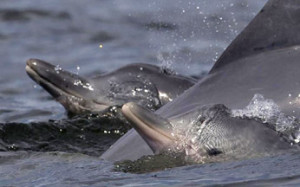By Traci Watson
Scientists are spotting fewer of the biggest whale sharks in global oceans, but no one is sure why.
Whale sharks in Western Australia are among the best studied populations in the world.
Photograph by Brian J. Skerry, National Geographic Creative
You’d think finding something as big as a school bus would be a cinch.
But large whale sharks—the biggest fish in the sea—seem to have vanished from the world’s oceans, scientists say.
Until a decade ago, adult whale sharks measuring an awesome 43 to 49 feet (13 to 15 meters) plied warm waters from India to Belize.
Today these biggest of the big are seen only in the eastern Pacific, a new study says. Animals elsewhere average a mere 23 feet (7 meters) and under, which are small fry too young to breed. (Read more about the incredible lives of whale sharks.)
“Where are they?” marine ecologist Ana Sequeira of the University of Western Australia says of the big guys.
“We urgently need to know. … We need to have the big mums and big dads to keep the species going,” says Sequiera, who led a new study about the phenomenon.
But how whale sharks go about their business is a secret they keep to themselves.
Researchers still don’t know basic facts about the fish, such as its global population or why whale sharks gather in groups, called “coastal aggregations,” in shallower waters. (Related: “Secrets of Whale Shark Migration Revealed.”) Troubling Trend
Sequeira and her colleagues recently delved into the lives of whale sharks at western Australia’s Ningaloo Reef, home to one of the world’s best-studied coastal groups.
After reviewing decades of observation data, the team found a troubling trend: The biggest animal spotted on the reef in the mid-1990s was 43 feet (13 meters long), but only 33 feet (10 meters) in the early 2000s, and an even more modest 26 feet (8 meters) a half-decade ago. (See amazing pictures of whale sharks worldwide.)
Watch: Putting a Camera on a Whale Shark
Scientists put Crittercams on whale sharks to get a glimpse of their underwater world.
The average size of Ningaloo’s whale sharks also shrank. In the most recent study period, the animals averaged only 20 feet (6 meters) from snout to tip, the scientists report in this week’s Royal Society Open Science. That meant most of the sharks were just kids.
A search of whale-shark data from other sites turned up similar data.
Except for some big females recently recorded near the Galápagos and Mexico, most very large whale sharks were seen before 2008, the study found, and the sharks in coastal groups are mostly immature animals.
Sweating the Small Stuff
So why are they getting smaller?
It’s possible the slow-growing animals, which live about 80 years, haven’t recovered from overfishing. Whale sharks are protected from hunting by some countries.
Or perhaps illegal or accidental kills are still jeopardizing the shark. In 2014, a nonprofit group provided evidence that a factory in southeastern China processes about 600 whale shark carcasses a year.
There are alternate explanations. Maybe whale shark gatherings have a youthful bias because big adults prefer to roam the deep ocean, says Eric Hoffmayer, a research fishery biologist at the U.S. National Oceanic and Atmospheric Administration. (See “Biggest Whale Shark ‘Swarm’ Found.”)
Whale shark measurements from groups other than Ningaloo aren’t totally reliable, adds whale shark expert Simon Pierce, of the California-based Marine Megafauna Foundation.
That makes it difficult to draw conclusions about whale sharks worldwide. Sequeira agrees: With the big kahunas MIA, it’s impossible to say whether the species—listed as vulnerable by the International Union for Conservation of Nature—is in serious decline.
But Pierce says other data from fisheries in Taiwan and mainland China suggest whale sharks have gotten smaller. And whale-shark sightings in several oceans have become less frequent.
“Whale sharks are definitely in a lot of trouble,” he says by email. “That’s a valid take-home message.”




